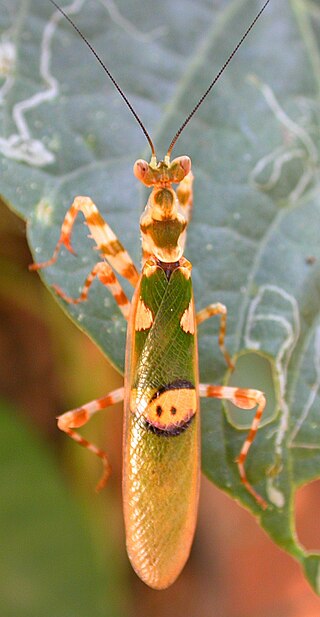
Hymenopodidae is a family of the order Mantodea (mantises), which contains six subfamilies. Some of the species in this family mimic flowers and are found camouflaged among them; these are called flower mantises. Their coloration is aggressive mimicry, luring prey to approach close enough to be seized and eaten.

The black vine weevil is an insect native to Europe but common in North America as well. It is a pest of many garden plants.

Creobroter is a genus of flower mantises in the tribe Hymenopodini; species are concentrated in Asia. The name comes from the Greek kreo-, meaning "flesh") and broter" meaning "eating", therefore, "flesh-eating", an apt name for a predatory insect. Both sexes have long wings and are capable fliers. Full-grown males are about 3 to 4 cm in length; females are about 4 to 5 cm.

Creobroter gemmatus, common name jeweled flower mantis, is a species of praying mantis native to Asia.

Otiorhynchus is a large genus of weevils in the family Curculionidae. Many species of the genus, particularly the black vine weevil and the strawberry root weevil, are important pests, both as larvae and as adults. Larvae feed on plant roots. Adults are flightless with fused elytra and feed at night on plant foliage. In many species of the genus at least some races are polyploid and parthenogenetic, while the rest of the races and species are diploid and bisexual. Otiorhynchus weevils, particularly O. scaber, have been a popular subject for studies of the evolution of parthenogenesis. The genus is native to the Palearctic region. However, sixteen species were inadvertently introduced to North America and have become widespread there.

Otiorhynchus morio is one of the many species in the weevil family (Curculionidae). It was first described by German entomologist Ernst Friedrich Germar in 1824.

Dardanus gemmatus, the jeweled anemone hermit crab, is a species of hermit crab native to tropical reefs surrounding the Indo-Pacific, typically at depths of 2–100 metres (10–330 ft).

Monoplex gemmatus, is a species of predatory sea snail, a marine gastropod mollusk in the family Cymatiidae.

Otiorhynchus armadillo is a species of broad-nosed weevil belonging to the family Curculionidae, subfamily Entiminae.

Otiorhynchus rhacusensis is a species in the weevil family (Curculionidae).
Tepidamorphus gemmatus is a slightly thermophilic, Gram-negative and rod-shaped bacterium species from the genus of Tepidamorphus which has been isolated from a hot spring from the Furnas area on the São Miguel Island on the Azores.

Otiorhynchus singularis is a species of weevil native to Europe.

Otiorhynchus meridionalis, the lilac root weevil, is a species of broad-nosed weevil in the family Curculionidae. It is found in North America. Lilac root weevils are shiny, brownish-black beetles, about 0.25 inches (0.6 cm) with long snout (rostrum) and geniculate (elbowed) antennae. They are common landscape pests, feeding on lilac, euonymous and peonies.

Otiorhynchus crataegi, the privet weevil, is a species of broad-nosed weevil in the beetle family Curculionidae.

Panscopus gemmatus is a species of broad-nosed weevil in the beetle family Curculionidae. It is found in North America.

Otiorhynchus raucus is a species of broad-nosed weevil in the beetle family Curculionidae. It is found in North America.
Otiorhynchus ligneus is a species of broad-nosed weevil in the beetle family Curculionidae. It is found in North America.
Otiorhynchus porcatus is a species of broad-nosed weevil in the beetle family Curculionidae. It is found in North America.

Otiorhynchus rugosostriatus, known generally as the rough strawberry root weevil or rough strawberry weevil, is a species of broad-nosed weevil in the beetle family Curculionidae. It is found in North America.

Otiorhynchus carinatopunctatus is a species of broad-nosed weevil in the beetle family Curculionidae. It is native to Europe and introduced in North America.















